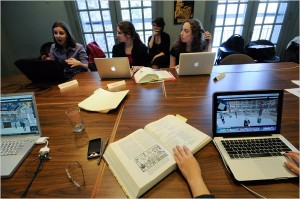I recently designed a syllabus for a course at NYU on writing for digital media. Unlike most of my writing courses, which focus on journalism, this was meant to have broader appeal: marketing, advertising, blogging, and public relations were included in the weekly readings and assignments.
And the university had a unique request: try to incorporat
e some online components into the course.
During a meeting to discuss the course I’d designed, another professor and I got into a lengthy talk about the merits of online education. While she was probably 10 years older than me, we had both been educated in an age well before computers joined toothbrushes and drip-coffee makers as standard equipment for modern life. We agreed that there are surely ways for digital technology and the Internet to aid education, but our skepticism still runs deep.
After all, for us, education was something that happened in real time, in real space, with some students, a teacher or two, and paper in various forms spread out on a wooden surface between us.
Today’s New York Times had an article about colleges — many of them elite — incorporating such online components in their curricula, particularly in humanities courses. The professors in the piece come across as enthusiastic as their students, if not more so. They describe how classics 500 years old take on new life in these virtual worlds, allowing students to access them and engage critically with them in ways we couldn’ t have imagined jus t 15 years ago.
Reflecting on my own course, and my reluctance in adding anything that would minimize my face-time with the students, I started to wonder if I’m even more old-fashioned that I’d thought. So I ask the Contrary community, if you’ve ever had an online educational experience, please share your thoughts, whether positive, negative, or otherwise. I, as one educator trying desperately to stay current, would love to hear them.


Comments on this entry are closed.
Well, I’ve taken online courses, offered by the University of Illinois, to learn online teaching. I’ve used what I learned in those courses to teach online though the Chicago City Colleges. Those all went pretty well, I thought, especially for people who have jobs and children and other demands on life that prevent them from attending brick and mortar colleges during traditional hours.
It’s as you might expect from reading education journals—every nuance of digital education has been picked apart and written about relentlessly by education profs and grad students. There are advantages and disadvantages to both of these categories of education, they’ve concluded, but most important: any problem you might have… there’s training out there to help you solve it.
This past quarter I tried something different. I taught a face-to-face journalism course in a brick-and-mortar computing classroom. We met twice a week, with Macs on our desks. The course was almost paper free—I handed out a syllabus on the first day and an evaluation form on the last day. The reading and writing all happened online. The workshopping and discussion all happened in the classroom.
What I wished for in that instance was that the computers would disappear into the desks now and then, and the desks arrange themselves in a rectangle so that we could change at will between a computing classroom and a traditional University of Chicago seminar room. That would offer the best of both worlds. Of course, with the right computers and the right desks, this is entirely possible.
My bottom line for online education is the same as it has been for online journalism—it’s coming, so best to welcome it and get ready.
Thanks, Jeff. I agree that we’re better off accepting it than bemoaning it. However, I also know that I’m old-school (this may be the first time that I’ve used that expression in a context that makes sense) enough to be insecure about how to best incorporate digital technology.
In my classroom at Hunter, the students sit in a large circle around the room, facing computers that sit on a ledge that wraps around three sides of the classroom. I stand at the front. The great thing is that the students sit on chairs with wheels that swivel around, so they’re not locked into their positions in front of their Macs.
I run my course paperless as well, but the ability to go back and forth between digital and real-space makes a big difference.
Fortunately, NYU offers courses on how to best implement digital technologies in your syllabi and teaching, so if I wind up teaching this course, you can be sure that I’ll take full advantage of that.
Having taught “computer” classes to high school students, I found that once they got on the computers it was impossible to get them away from them. Therefore, I did my talking at the beginning of the class. I explained what everybody needed to know that day and then let them go to it on their computers while I provided help individually from behind. It truly was a “guide-on-the side” situation, rather than “sage-on-the-stage.” This was 10 years ago, and educators were predicting this would be the model for all classes in the future. I don’t think it has happened yet, but I can’t imagine teaching a computer class any other way. Plenty of teachers do though.